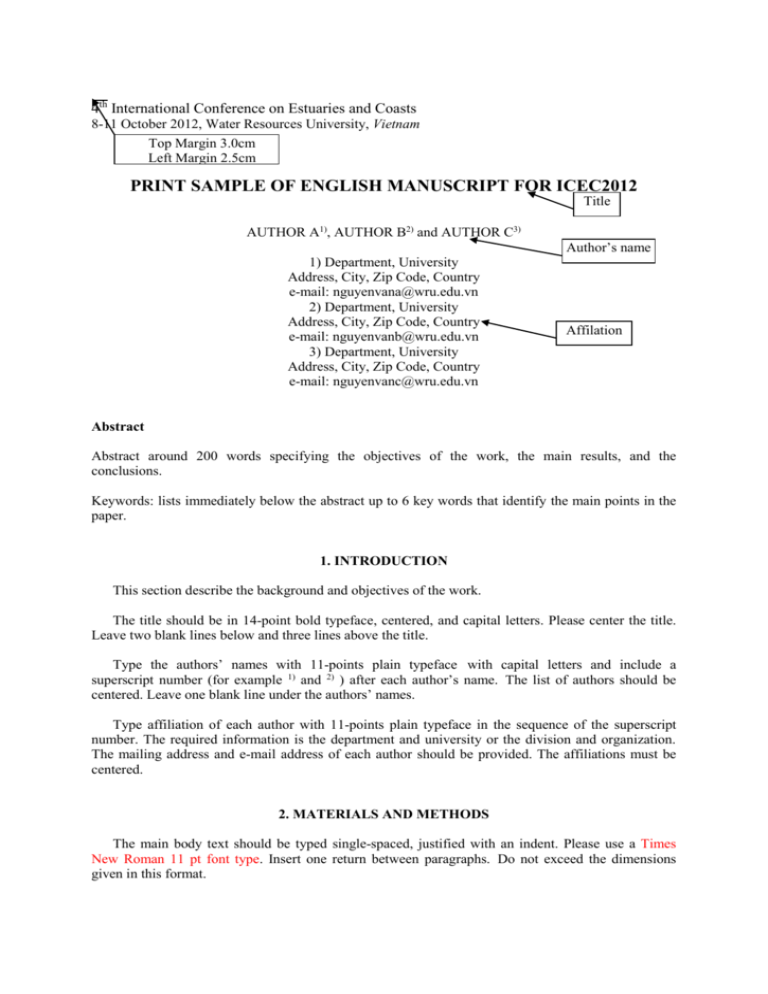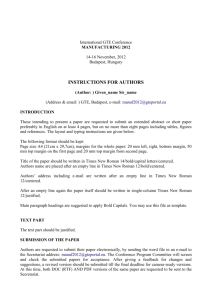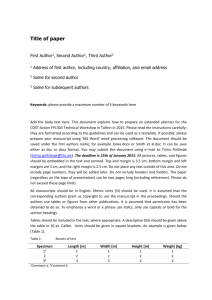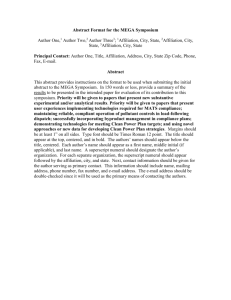print sample of english manuscript for icec2012
advertisement

4th International Conference on Estuaries and Coasts 8-11 October 2012, Water Resources University, Vietnam Top Margin 3.0cm Left Margin 2.5cm PRINT SAMPLE OF ENGLISH MANUSCRIPT FOR ICEC2012 Title AUTHOR A1), AUTHOR B2) and AUTHOR C3) Author’s name 1) Department, University Address, City, Zip Code, Country e-mail: nguyenvana@wru.edu.vn 2) Department, University Address, City, Zip Code, Country e-mail: nguyenvanb@wru.edu.vn 3) Department, University Address, City, Zip Code, Country e-mail: nguyenvanc@wru.edu.vn Affilation Abstract Abstract around 200 words specifying the objectives of the work, the main results, and the conclusions. Keywords: lists immediately below the abstract up to 6 key words that identify the main points in the paper. 1. INTRODUCTION This section describe the background and objectives of the work. The title should be in 14-point bold typeface, centered, and capital letters. Please center the title. Leave two blank lines below and three lines above the title. Type the authors’ names with 11-points plain typeface with capital letters and include a superscript number (for example 1) and 2) ) after each author’s name. The list of authors should be centered. Leave one blank line under the authors’ names. Type affiliation of each author with 11-points plain typeface in the sequence of the superscript number. The required information is the department and university or the division and organization. The mailing address and e-mail address of each author should be provided. The affiliations must be centered. 2. MATERIALS AND METHODS The main body text should be typed single-spaced, justified with an indent. Please use a Times New Roman 11 pt font type. Insert one return between paragraphs. Do not exceed the dimensions given in this format. The maximum page number is eight (standard A4 sheet; 21.0 cm wide by 29.7 cm long). The upper margin is 3.0 cm. The bottom, left, and right margins are 2.5 cm. 3. RESULTS AND DISCUSSIONS A clear presentation of experimental results obtained, highlighting any trends or points of interest. 4. CONCLUSIONS This section should be a brief explanation of the significance and implications of the work reported. References should be listed at the end of the paper in alphabetical order of the first author’s last name and not separated by each other. Make sure all references are complete, including last names and initials of all authors, year of publication, title of paper or book, volume number, issue number, publisher (in case of books), city of publication, and page numbers. Reference should be cited in the text by indicating the last name of the first author and the year of publication, for instance, Otaki et al. (1998). 5. ACKNOWLEGEMENTS Financial support provided by any organizations can be acknowledged. 6. REFERENCES De Bonis P., Fattoruso G., Pagano A., Pasanisi F. (2002). Transport of pollutants in coastal areas: a comparison among different mathematical models. In: Appropriate Environmental and Solid Waste Management and Technologies for Developing Countries, G. Kocasoy, T. Atabarut and I. Nuhoglu (Eds), vol. 5, Bogaziçi University Press, Istanbul, pp. 2741-2748. Hassan H. (1997). Water Quantity and Quality Assessment for Suwa Lake and Tenryu River Basin Regarding the Impact of Future Climate Change. PhD thesis, Department of Urban Engineering, The University of Tokyo. Otaki M., Yano K. and Ohgaki S. (1998). Virus removal in a membrane separation process. Wat. Sci. Tech., 37(10), 107-116. Right margin 2.5cm Bottom margin 2.5cm






